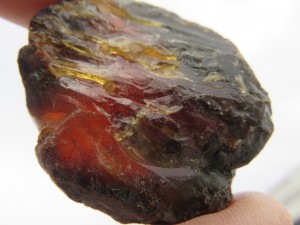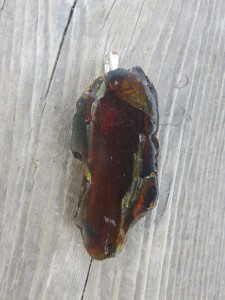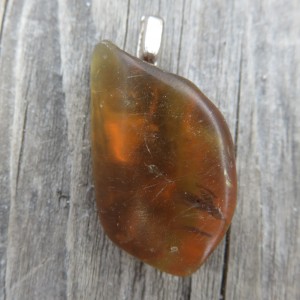Amber is often referred to as a gemstone for its beauty and rarity but is actually a fossil. Amber is the fossil remains of tree resin. The amber we sell is from Indonesia and associated with seams of coal formed about 22 million geologic years ago during the Miocene era. The color ranges from mostly dark amber to tan and some with banding of both. Most are translucent and some with “fire.” Amber is easy and fun to work with and creates beautiful jewelry and carved works of art. Amber can come in a range of color. Copal, often sold as amber, is tree resin that is not fossilized.

How do you know it is real amber? We like to know that we are selling quality material at a good price. Here are some things that we have done to authenticate our amber:
- Speak with the seller in detail about the authenticity and source of the amber
- Examined pieces for color (dark translucent amber, in our case), natural cracks (some appropriate), inclusions (dirt, some appropriate), lack of air bubbles (bubbles could occur with amber melted down and mixed with plastic) Note: insects in amber are rare and are almost always fake.
- Took samples of our amber to two long time lapidary enthusiasts that examined and worked some pieces
- Performed some simple tests: First, does it float in salt water equal to that of the sea. Second, when burned or worked does it smell like tree resin (pine, in our case) or does it smell like plastic (much fake amber is plastic or low quality amber melted together with plastic). Third, rub with alcohol, copal will become sticky, amber should not). Fourth, check amber under ultraviolet light. Real amber usually will fluoresce. Our samples did.
How do I work with amber?
- Amber is light, like plastic, is easily cut with any saw, shaped with most carving tools (rotary tools with attachments), and sandpaper of various grits. Lapidary and glass equipment work as well. Buff with soft leather or denim.

Heat caution If amber gets too hot it can crack, crumble or melt. Keep water handy or use lapidary or glass equipment that has a flow of water to help cool your piece.

Other uses for amber include use in perfumes. As mentioned above, amber, when burned has a pleasant aroma of what we like to call “earthy pine.” We do not how healthy that is, but it sure smells nice.
If you would like to purchase amber, or have more questions, please Contact Us

